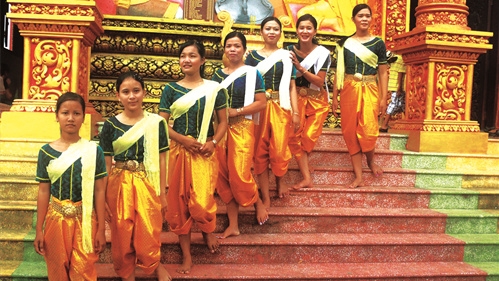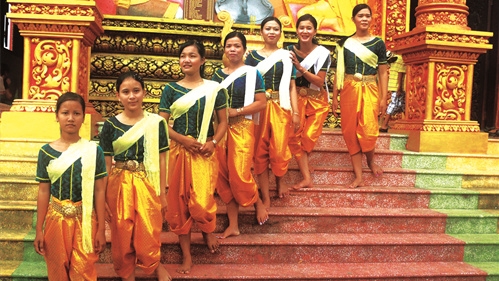


|
 Khmer women dressed in costumes for celebrations (Photo: VNA)
| |
|
Tri Ton and Tinh Bien districts, An Giang province, are home to
a large number of Khmer people in Vietnam. The costumes of the Khmer people
in An Giang are divided into daily costumes and costumes for celebrations.
The Khmer are famous for Tkat and Batik dying techniques which
produce shiny black silk and cotton fabrics.
In their daily lives, Khmer women wear colourful collarless silk
shirts which are embroidered with motifs of oval inlays, flowers and stripes.
The dresses are a mixed ‘sarong’, a 3.5 metre long and one metre wide piece
of delicately embroidered cloth, which is wrapped around the upper leg and
the rest slipped between the two legs to make a short and bulging pants.
The traditional costume of Khmer men is a sarong, a long piece
of delicately embroidered cloth. They also often wear a combination of
sarongs and black blouses.
The elegance of the Khmer people’s traditional costumes are
vividly represented at festivals and wedding celebrations. At weddings, Khmer
people wear their most beautiful costumes. Female guests at the wedding are
dressed in costumes in flamboyant colours: green, red, purple, and yellow.
The bride often wears a red or lotus pink gown and a short,
sleeveless top. The gown and the top are closefitting thanks to a metal belt.
The bride ties a golden silk scarf from her shoulder to her hip.
The bride also puts on a tower-shaped hat decorated as a
beautiful crown with sparkling beads or embroidered flowers.
The groom wears a red Hol dress and long sleeved blouse. He ties
a white scarf across his body and wears a knife on his belt as a symbol of
protection for the bride.
|
Source: NDO